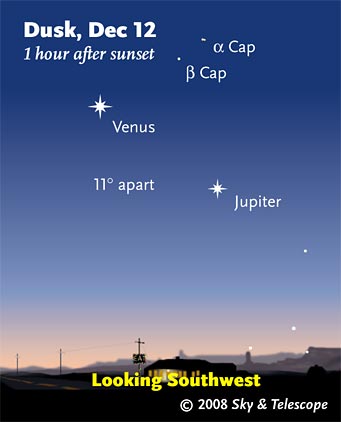
Sky at a Glance | March 13th, 2009
Brilliant, thin-crescent Venus gets really interesting this week as it sinks lower in the western twilight on its way to inferior conjunction. Thin-ringed Saturn is well up in fine view in the east by late evening. And fading Comet Lulin once again has a dark moonless sky.
The Lost Siblings of the Sun
The Sun and solar system formed 4.6 billion years ago amid a rich cluster of other newborn stars. Where are they now?
Sky at a Glance | March 6th, 2009
Brilliant Venus is moving lower in the western twilight, as it thins to an eerie crescent in a small telescope. Saturn is at opposition, shining high in the southeast by late evening. And in the same constellation as Saturn, the biggest asteroid, Ceres, continues its best showing of our lifetimes.

Sky at a Glance | February 27th, 2009
Venus, shining in the western twilight, has a gorgeous naked-eye pairing with the crescent Moon on Friday Feb. 27th. Comet Lulin is fading this week but still visible in binoculars. And the biggest asteroid, Ceres, continues its best showing of our lifetimes.
Sky at a Glance | February 20th, 2009
It's a mighty busy sky week! Comet Lulin is now at its closest and brightest. The biggest asteroid, Ceres, is having its best showing of our lifetimes. Not just one but four of Saturn's satellites, and their shadows, will cross Saturn's face in one night. And Venus has a gorgeous naked-eye pairing with the crescent Moon.

Sky at a Glance | February 13th, 2009
Venus is shining the highest and brightest it ever gets! If your evenings are very dark, can you see your faint Venus-shadow on snow or a white sheet on the ground? Later in the night, nearly-ringless Saturn climbs into good view in the east. And Comet Lulin is almost at its nearest and best, now in a moonless sky.

DIY: Astronomy Projects & Guidance
Image Stabilize Your Binoculars
You see much more of the universe in a steady view than in a jiggling view. Change your binocular observing forever with this easy-to-make stabilizer frame.

Sky at a Glance | February 6th, 2009
Venus continues blazing high, Mercury is now up in view before sunrise — and for western North America, the full Moon undergoes a penumbral (weak) eclipse before sunrise on Monday the 9th.
Sky at a Glance | January 30th, 2009
Venus is near peak brilliance, outshining everything in the evening sky but the Moon. Saturn shines high in the early-morning hours, when you can also try for the incoming Comet Lulin.
A Supermassive Double Black Hole?
A far-off quasar seems to contain two giant black holes hurtling around each other less than a light-year apart. They're doomed to spiral together and join in a literally space-shaking crash — but when?
Sky at a Glance | January 23rd, 2009
Venus is nearing its peak brilliance, outshining everything else in the evening sky — until the Moon joins it late in the week. And Saturn is now rising as early as 8 or 9 p.m.

Sky at a Glance | January 16th, 2009
Venus dazzles high in the evening, with Uranus right near it but 15,000 times fainter. Still, you can spot Uranus with binoculars. And Saturn is now rising as early as 9 p.m.

Sky at a Glance | January 9th, 2009
Venus dazzles high in the cold winter dusk, and a telescope shows that it's almost perfectly half-lit. Before dawn, Saturn's rings remain the closest to edge-on that you can see them until 2038.

Sky at a Glance | January 2nd, 2009
Venus dazzles ever higher in the cold winter dusk. If you brave the even colder early-morning hours, the Quadrantid meteors may reward you overhead. Before dawn, Saturn's rings remain the closest to edge on that you can see them until 2038.

Sky at a Glance | December 26th, 2008
Venus shines ever brighter and higher in twilight, passing stars and Neptune and then pairing spectacularly with the Moon. Jupiter, far to its lower right, meets Mercury. Before dawn, Saturn's rings are the closest to edge-on you can see them for years to come.

Sky at a Glance | December 19th, 2008
Venus shines brighter and higher in the southwestern twilight, passing stars and Neptune. Jupiter is sinking down far to its lower right. After dark, Orion season is now in full force. And at dawn, Saturn's rings are the closest to edge-on you can see them for years to come.

Sky at a Glance | December 12th, 2008
Venus and Jupiter continue to draw apart in the southwestern twilight. The Geminid meteor shower arrives amid bright moonlight. And Saturn, now with edge-thin rings, is very high in excellent telescopic view just before dawn.
Tycho's Supernova in Reruns
436-year-old light echoes give a look today at a blast in the Renaissance past. The catch? They're only a twenty-billionth as bright as the original.

Sky at a Glance | December 5th, 2008
Following their conjunction, Venus and Jupiter are now drawing apart in the southwest at dusk — still a striking sight. And Saturn, with its nearly edge-on rings, is a fine telescopic attraction if you can get yourself out before dawn.
A Very Oddball Comet
Periodic Comet Machholz 1 has such a unique composition that a researcher suggests it may have come from another solar system. Though the odds against this seem long.
